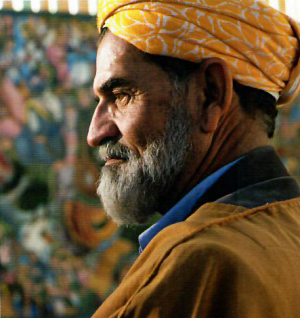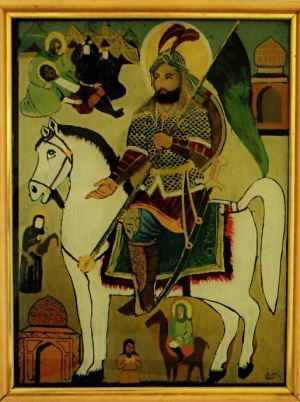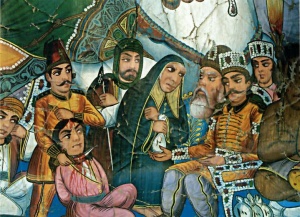Qasem daneshpajouh: Difference between revisions
mNo edit summary |
m (Text replacement - "Husayn" to "Hussain") |
||
| Line 30: | Line 30: | ||
One of the painted curtains of Karbalai Qasem which he uses on long trips is one of dimensions 40 by 70 CMS. The main curtains are usually depicted in dimensions around 2 by 4 M. or 1.5 by 3 M. On trips, because of the weight of the huge curtains, sometimes curtain frames or Ghabpardehs are used. The number of faces on the Ghabpardehs are much limited compared with those on the main curtains, and consist of main characters such as [[Abbas ibn Ali]] and the story that is to be narrated. | One of the painted curtains of Karbalai Qasem which he uses on long trips is one of dimensions 40 by 70 CMS. The main curtains are usually depicted in dimensions around 2 by 4 M. or 1.5 by 3 M. On trips, because of the weight of the huge curtains, sometimes curtain frames or Ghabpardehs are used. The number of faces on the Ghabpardehs are much limited compared with those on the main curtains, and consist of main characters such as [[Abbas ibn Ali]] and the story that is to be narrated. | ||
==Narration== | ==Narration== | ||
It is said that 72 stories are narrated in a picture-storytelling, which probably is connected to the fact that those accompanying [[Imam | It is said that 72 stories are narrated in a picture-storytelling, which probably is connected to the fact that those accompanying [[Imam Hussain]] in [[Karbala]] were also 72. The subject of the narrated story concerns an old weaving woman of Neishabur and Mutawakkil, the ruling Abbasid Caliph. The old weaving woman from Neishabur (in the east of Iran) goes on pilgrimage to Karbala in Iraq to the grave of Imam Hussain. Mutawakkil-e Abbasi, who opposed to Imam Hussain, were ordered to his executors to throw the old woman into the Euphrates river. With prayers and the shouts of the old woman, Abbas who was one of Imam Hussain's followers rushes to her help. The old woman is saved and reaches her goal in pilgrimage and visits the shrine of Imam Hussain and Abass ibn Ali.[[File:Qasem daneshpajouh 7.jpg|thumb|]] | ||
==Source== | ==Source== | ||
* Ardalan, hamidreza (2008). Picture-storyteller masters of Iran, the Iranian academy of the art, 2008, volume 13. ISBN: 978-964-2986-071(vol.13). 978-964-2986-002(set). | * Ardalan, hamidreza (2008). Picture-storyteller masters of Iran, the Iranian academy of the art, 2008, volume 13. ISBN: 978-964-2986-071(vol.13). 978-964-2986-002(set). | ||
Revision as of 14:55, 22 September 2019
Karbalai Qasem Daneshpajouh (born in 1942) is an Iranian Pardekhan, Chavoshikhan, Maddah, Manaqib-khan. He had several masters including Morshed Mohammad Ali (his father, Habibollah Chavoshi, Arefi, Karbalai Akbar. He started Pardekhani when he was only six years old.
Performance Method
Karbalai Qasem narrates the events in declamation. The chanting comes in at points of climax of the performance. His narration has a simple predictable tone which is comprehensible to indigenous people. With regard to his small curtain-frame, it is impossible to manifest the usual figures such as: fighting, festivity, and using cane (as a performance object). Even so, Karbalai Qasem is very successful with his unassuming, simple and fluent mode in his narrations.
Reciting Method
The singing of Karbalai Qasem is made up of short composed phrases. He usually narrates his sung stories based on one of the known Iranian melodies. In the music of Neyshabur's Old Woman and Mutawakkil, ‘Abbasid Caliph, Morshed Karbalai Qasem starts with the second Dong of Mahur (second note of the second Dong). The section of Har ke darad havas e karbobala ..., moves into the first Dong and with the hemistich of Har ke darad havas e noql o hana... descends on the Shahed note.
The repeated cutting off of the singing and then limited and mixed narrations with the spoken prose, causes the unexpected referral to different Gushes on the spur of the moment, and consequently some of the compositions of the melodies or notes cannot be corresponded with known intervals of the Dastgah (mode) or Gushes of Mahur. For example, in Chavosh man az va'ez shenidam, we cannot definitively say whether the intervals are related to the Mahur Dastgah or not, especially when the role of the spoken speech becomes more emphasized than the melodies.
Ghabpardeh (Small Framed Curtains)
One of the painted curtains of Karbalai Qasem which he uses on long trips is one of dimensions 40 by 70 CMS. The main curtains are usually depicted in dimensions around 2 by 4 M. or 1.5 by 3 M. On trips, because of the weight of the huge curtains, sometimes curtain frames or Ghabpardehs are used. The number of faces on the Ghabpardehs are much limited compared with those on the main curtains, and consist of main characters such as Abbas ibn Ali and the story that is to be narrated.
Narration
It is said that 72 stories are narrated in a picture-storytelling, which probably is connected to the fact that those accompanying Imam Hussain in Karbala were also 72. The subject of the narrated story concerns an old weaving woman of Neishabur and Mutawakkil, the ruling Abbasid Caliph. The old weaving woman from Neishabur (in the east of Iran) goes on pilgrimage to Karbala in Iraq to the grave of Imam Hussain. Mutawakkil-e Abbasi, who opposed to Imam Hussain, were ordered to his executors to throw the old woman into the Euphrates river. With prayers and the shouts of the old woman, Abbas who was one of Imam Hussain's followers rushes to her help. The old woman is saved and reaches her goal in pilgrimage and visits the shrine of Imam Hussain and Abass ibn Ali.
Source
- Ardalan, hamidreza (2008). Picture-storyteller masters of Iran, the Iranian academy of the art, 2008, volume 13. ISBN: 978-964-2986-071(vol.13). 978-964-2986-002(set).



